I first created this site back in 1998 to document the wild plants that I encountered. But it has grown into a clearinghouse of information on landscaping, backyard birds, butterfly gardening, plant identification and making paper from plant fiber. After leaving Kansas, I thought of deleting the site. But realize it has a wealth of information that people rely upon.
Hosting the site is involved. I’d like to thank those who have donated to help defray the web site hosting fees. If you would like to contribute, please click the Donate button. Thank you.
Northern Flicker Nesting
Flicker Topics
- About Flickers
- Nest Boxes
- Mounting Nest Boxes
- Starlings
- Insects
- Feeding
- Native Trees
- Courtship
- 2014 Nesting
- 2015 Nesting
- 2016 Nesting
- 2017 Nesting
- 2018 Nesting
- 2019 Nesting
About Flickers

The northern flicker is a Cavity Nesting Bird. Being woodpeckers they can excavate their own cavities but they will use Nest Boxes. Flickers are very well adapted to backyards with short vegetation and scattered trees. Flickers don't like dense woods. They are a bird of open country and they do much of their feeding for insects (mostly ants) on the ground.
Flicker populations are in decline. Their numbers decreased by 46 percent between 1966 and 2010, according to the North American Breeding Bird Survey. I believe starling competition for nesting sites is the main reason for their decline. And as the starling populations increases it makes it that much harder for flickers to nest successfully. Starlings are an unprotected invasive species.
Playlist of Northern Flickers Videos
Enjoy this playlist of flickers drumming and calling as well as flicker chicks inside the nestbox.
Nest Boxes for Flickers
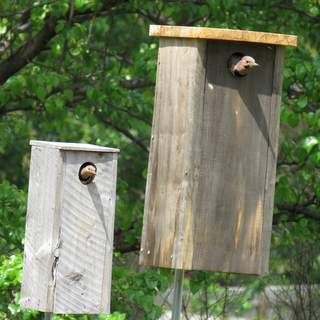 Flickers in both nest boxes
Flickers in both nest boxesPutting up a Nest Box designed for flickers will provide a possible nesting site for them. If you decide to install a nest box, you MUST commit to trapping an eliminating starlings as well. If you only erect a nest box and don't control starlings, you will have starlings nesting in the nest box. If you do not want to trap and kill starlings, then don't put up a nest box. Starlings are an invasive species that attack and drive flickers from their nesting sites.
Have you decided to commit to monitoring a flicker nest box and controlling starlings? If so, then you need a nest box. But what is the best nest box for a flicker? After searching various sources for information on nest boxes for flickers, I found the following recommended dimensions for flicker nest boxes.
- Backyard Birdhouse Book by Laubach suggests using 1" thick cedar lumber, a 7¼" x 7¼" base and 22" long sides
- Woodworking for Wildlife by Henderson suggests using 2" thick planed lumber, a 6 ¼" x 6 ¼" base and 24" long sides
- Woodcrafting for Wildlife suggests using 2" thick planed lumber, a 4¼" x 7¼" base, and 24" long sides
- Washington Dept. of Wildlife suggests 1" cedar lumber, a 6" x 7½" base, and 23" long sides
These suggestions may all work but I wanted the optimum nest box for flickers. According to Life History of American Birds a Northern Flicker's natural cavity average size is 7.67" in diameter. This equates to roughly 46 square inches of floor space. Based upon this, I believe the best floor dimension for flickers is roughly 7" square.
The depth of natural flicker nesting cavities range from about 9" to 36". Because nest boxes have space above the entrance hole that a natural cavity does not have, I decided a deeper nest box would be better than a shallow one. Furthermore a deep nest box would keep the birds safer from avian predators. The recommended boxes ranged from 22" to 24", I believe any of those depths are suitable for a nest box.
When building a nest box, I believe 2" lumber (which is actually 1.5" thick after drying and planing) would create a nest box that is too heavy to mount and monitor easily. Therefore I would recommend using 1" lumber.
If you decide to purchase a nest box instead of building one, be sure to check the inside dimensions. I found that some commercially available nest boxes are relatively shallow. Check the dimensions before you buy. If they aren't at least 20" deep, they may not be preferred by flickers. Furthermore some commercial nest boxes have a hole guard on them to prevent squirrels from enlarging the hole. The problem with this is that flickers often like to enlarge the hole. Using a baffle is a better way to prevent squirrels from using the nest box.
To summarize, my preferred dimensions for a flicker nest box is roughly a 7" square floor, 23" long sides made of roughly 1" thick wood. The wood should be untreated.
Building a Flicker Nest Box
Are you ready to build a flicker nest box? The first thing you need to do is choose the kind of wood to use. Light weight wood is best as the nest box will be relatively large. The wood should not be treated. The most readily available woods are white pine and western red cedar. Both are light weight. The cedar is also rot resistant but it does cost more than the pine.
If you have a source of 1" unplaned lumber, I would recommend using it. Check with local sawmills. I found soft maple at our local sawmill. Since most lumber suppliers only carry planed lumber, you may have to use it. Planed 1" white pine is actually Mar 4" thick. Western red cedar is available planed on only one side and is 7/8" thick. Either of these would be suitable for building a nest box for flickers.
The benefit of using rough western cedar is the rough side can be placed facing the interior of the nest box. This will allow the flickers to cling easily to the sides of the box. This is especially important for the young as they climb to the hole to be fed.
If planed lumber is used on the inside of the box, all interior sides should be scored with a flat head screw driver to roughen the surface. Using the edge of the screwdriver, score the wood by scratching lines spaced about 1/8" a part perpendicular to the length of the board. Do this to all inside surfaces of the nest box. The goal of scoring the wood is to make it rough enough that the birds can climb up and down the surface.
If you combine an 8" planed board with a 10" one, you can make a flicker box with a base of 7¼" x 7¾" which is close to a 7" square nest box. The benefit of using an 8" and 10" board is the boards only have to be cross cut. Use 12" lumber for the roof of the nest box as you want it to be larger than the nest box.
Nest Boxes provides detailed information on building various sized nest boxes out of white pine.
Preparing the Nest Box
Flickers will not nest in an empty nest box. They do not build a nest. They are excavators that normally would excavate a cavity in a tree. Their "nest" is just a depression in the wood chips they create from excavating.
To entice flickers to nest in a nest box, the box should be filled about half full with hardwood wood shavings in early winter. By only filling the nest box half full, flickers are still able to inspect and roost in the nest box during the winter. Soft aspen shavings are best and can be purchased at any store that sells animal bedding. Don't use softwood shavings such as pine or cedar as they are full of splinters which could hurt the young.
The wood shavings I use are labeled as "Aspen Animal Bedding."
Flickers like to excavate their own nest, as this is part of their courtship process. Once a pair has selected your nest box as a nesting site, you should see them excavating the box. Look for wood shavings on the ground as a sign that they have been excavating. Note that starlings will also excavate nest boxes and throw the shavings on the ground.
Some sources suggest filling the box completely full of wood shavings to prevent starlings from nesting in the nest box. But this also prevents the flickers from roosting in the boxes during winter. The fact that they roost in the boxes in late winter may encourage them to nest in them as well.
Flicker Nest Box #1
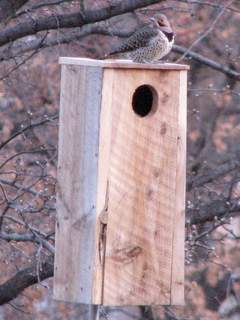 Male Yellow-shafted Flicker on Nest Box
Male Yellow-shafted Flicker on Nest BoxAt the end of 2013, I built the box in the picture using 1" thick rough cut eastern red cedar. It was built with scrap lumber and was the largest size I could build based on the size of the lumber scraps. The dimensions of the box are as follows.
- Sides: 21" long, 7 ½" wide (this makes a 20" deep nest box)
- Front & Back, 21" long, 6 ½" wide
- Recessed base: 5 ½" x 6 ½" (this is about 36 square inches of space)
- Hole: 2 ½" wide x 3" tall (based on size of natural hole)
The box opens from the top. The top is held in place with two screws, each kitty-corner from the other. One screw can be loosened to rotate the top open. This allows the box to be filled with wood shaving, aids in removing trapped starlings using a Nest Box Trap, and allows monitoring of the box.
In 2014 a pair of flickers chose this box as a nesting site. I built it before I knew what the optimal size for a nest box should be, but it was large enough to accommodate them. Unfortunately starlings drove the pair from the nest box as they were laying their clutch of eggs.
The flickers chose a larger nest box for nesting in 2015, but one used this box for a roost site.
I do NOT recommend this size of box or using eastern red cedar in its construction.
Flicker Nest Box #2
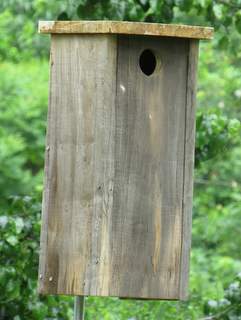 Soft Maple Flicker Nest Box (2' long)
Soft Maple Flicker Nest Box (2' long)At the end of 2014, I decided to build a larger next box based on my research on flicker nest boxes. I wanted to use rough cut wood for the nest box as it would better replicate a natural cavity's rough interior. There is a local saw mill, Kansas Hardwoods Inc, which specializes in sawing local trees. I wanted to build a relatively light weight next box, so I chose soft maple.
The dimensions of the box are as follows.
- Sides: 23" long, 10" wide
- Front & Back, 23" long, 7" wide
- Recessed base: 7" x 8"
- Hole: 2 ½" diameter
The box has interior dimension of 22" deep and a 7" x 8" floor. That gives the flickers 56 square inches of floor space.
The roof is attached with two screws located kitty-corner from one another to allow easy access to the nest box. Drip lines were cut in the roof of the nest box to prevent water from seeping in.
Flickers nested in this nest box in 2015, 2016, and 2017
I do not recommend making a nest box with 1" soft maple because of the weight of the box and the maple tends to warp.
Flicker Nest Box #3
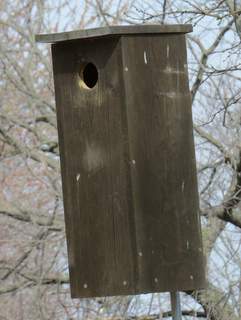 White Pine Flicker Nest Box (2' long)
White Pine Flicker Nest Box (2' long)At the end of 2015, I decided to build a nest box using finished 1" white pine lumber. I wanted a box that was lighter weight than the silver maple box (#2).
Because finished lumber is used on this box, all interior sides should be scored with a flat head screw driver to roughen the surface. Using the edge of the screwdriver, score the wood by scratching lines spaced about 1/8" a part perpendicular to the length of the board. Do this to all inside vertical surfaces of the nest box. The goal of scoring the wood is to make it rough enough that the birds can climb up and down the surface. This should be done before assembling the box.
The dimensions of the box are as follows.
- Sides: 24" long, 1" x 10" pine board (actual size is x ¾" x 9¼")
- Front & Back, 24" long, 1" x 8" pine board (actual size is ¾" x 7¼")
- Recessed base: 7¾" long 1" x 8" pine board (actual size is ¾" x 7¼")
- Hole: 2½" diameter
- Roof: 12" long, 1" x 10" pine board (actual size is ¾" x 9¼")
The box has interior dimension of 23" deep and a 7¼" x 7¾" floor. That gives the flickers 56 square inches of floor space (same space as a 7" x 8" base).
The roof is attached with four screws located at each corner. I use a cordless drill to remove the top to check the nest. Drip lines are cut in font and back edge of the roof to prevent water from seeping in. The roof overhangs on the front, back, and sides.
After having their nest destroyed by starlings, flickers renested in this box in 2016 and 2017.
This is my preferred nest box design.
Mounting a Nest Box for Flickers
The method of mounting the flicker box is as important as the design of the nest box. Mounting to a tree is not a good idea, as squirrels will be attracted to it as well as predators. Furthermore a nest box mounted on a tree is difficult and dangerous to monitor.
A much better technique is to mount the box on a telescoping pole that is attached to a T fence post. This allows the box to be located anywhere you can drive a T post in the ground. It's important to locate the nest box in an open area with a clear flight path to the box.
Get detailed instructions at Mounting Nest Boxes.
Starlings & Flickers
If you want flickers to nest, you must control starlings, an invasive species from Europe.
Besides erecting a nest box, you will need to implement Starling Control Traps as the starlings will prevent flickers from nesting. Starlings seek out flickers who are excavating a nest cavity. They will harass the flickers until the flickers abandon the cavity. They are more aggressive than flickers and are very persistent. In our cities and towns the starlings out number the flickers greatly. The flickers don't have a chance against the huge numbers of this invasive species. If you have a suet feeder, you probably know how many starlings visit your yard.
Here are some accounts of starlings stealing nest sites from flickers and other woodpeckers.
- Starlings competing with flickers for nest sites from American Artifacts, Birds in the Home Habitat
- Starlings usurping woodpeckers home from the Purple Martin Forum
Watch Starling trying to steal a nest box from a pair of flickers
After seeing this, I placed a nest box trap in a nearby flycatcher nest box. The starling entered this nest box and was captured.
Using Nest Box Traps to catch starlings
I have found the best way to trap starlings that are looking for nesting sites is to use nest box traps. I have erected numerous nest boxes in my yard that are about 12" deep and have a 2 inch entrance hole. Some of the nest boxes are designed for Red-bellied Woodpeckers and other for Great Crested Flycatchers. The boxes are mounted 10 feet high on telescoping poles. Each box allows the insertion of a Nest Box Trap. The flycatcher nest box, with its 5½" x 6" interior, seems to be preferred by starlings. Because it has 2" diameter hole, flickers can't enter but the starlings can. Learn more about the flycatcher nest box design and placement at Nest Boxes.
For each flicker nest box, you should have multiple flycatcher nest boxes (I have 4) located in my yard. The nest boxes should be placed in sunny areas as starlings seem to prefer nest boxes to be in open areas.
In Topeka, the starlings start seeking nesting cavities in early February and continue seeking them until about the end of May.
During February and March I keep traps in the flycatcher nest boxes continually. The only time I take the traps out is if I plan to be away for more than a day.
During April and May more of our native birds are beginning to nest and I only put traps in boxes that starlings begin to nest in. Once they have built a nest, I put the trap in. Once they build a nest, you can often catch the pair as the one that wasn't caught will come back to the nest box.
When starlings take up residence in one of my large nest boxes (flicker, screech owl, or wood duck), I replace the large nest box with a flycatcher nest box that has a trap set in it. Flickers often roost in these large nest boxes, so it is important to wait for them to exit the nest box in the morning before replacing the box with a flycatcher box. This is much easier than trapping them directly in the large nest boxes. It seems the starling is more attracted to the location than the actual nest box.
You must monitor the traps continually as there is a possibilty of catching a native cavity nester such as a bluebird. To minimize catching smaller cavity nesting birds, I find it helpful to have smaller nest boxes for them to use. This seems to keep them away from the flycatcher boxes.
Find more information on using Nest Box Traps.
Insects & Flickers
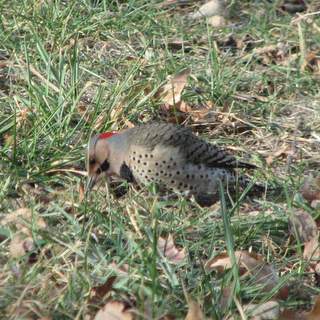 Northern flicker feeding on the ground
Northern flicker feeding on the groundBecause flickers feed on insects found in our lawns, it's important not to use lawn insecticides. If we kill all of the insects there will be nothing for adult flickers to feed their young. Not only do insecticides kill the insects that flickers rely on, they kill insects that other birds and animals feed on. Insects make up the vast majority of the food that birds feed their young. And if there are no insects there will be no baby birds. If there are no baby birds, there will be no adult birds.
Using native plants supports more insects which in turn supports more birds. Landscaping with native plants will benefit all bird species.
Ants make up the majority of the insects that flickers eat, so don't destroy ant colonies.
Feeding Flickers
Flickers and other woodpeckers love suet in the winter time. Putting out suet in the winter is the best way to attract flickers.
Suet is sold commmercially in cakes that can be served in suet cages. The cages can be hung on trees or from hooks.
An alternative to buying suet cakes is to make your own. I find that homemade suet is much prefered to the commercially available suet.
Learn more about using Homemade Suet to feed flickers and other native birds.
Occassionally I've seen flickers eat peanuts that I put in a platform feeder. I've never had them eat sunflowers from any of my feeders, unlike downy and red-bellied woodpeckers which eat them.
Flickers like fruit and you may attract them by putting out pieces of dried fruit.
Native Trees & Flickers
Native trees that are preferred by flickers grow to a large size and tend to have relatively soft wood that is easily excavated. Woodpeckers don't just need the trees for nesting, but also for foraging for food for their hatchlings. Alien tree species do not support insects which the birds need to raise healthy young. Native tree species support thousands of insect species that feed our native birds.
Some of the best trees for nesting flickers are the following. They all get to be rather large and they have relatively soft wood for easty excavating.
- Eastern Cottonwood (a favorite among most woodpeckers)
- Common Hackberry
- Silver Maple
- Peach-leaved Willow
Courtship Behavior of Flickers
Flicker woodpeckers have some very interesting behavior when it comes to establishing territories and engaging in courtship. I experienced this first hand in my yard once I installed a nest box for them. Often three birds are involved. One time I witnessed two males and a female; another time it was two females and a male. They would follow each other through the trees and sometimes landed on a nest box. Their movements include bobbing of the head and swaying of the body. They also utter an odd call as they "dance".
They also drum on my nestboxes. This seems to be a way to communicate their territory. Other times you will hear them just pecking lightly on the box. I fill the nest boxes with aspen shavings and when a flicker wants to use it for nesting or roosting, they will excavate the shavings.
Male Flickers fighting over a nestbox
Are these flickers competing for the same nest box or competing for the same female?
Female Flicker calling for her mate and drumming on a nestbox
I love it when the flickers drum on the nest box. It is one of my favorite sounds.
Male Flicker excavating a nestbox
It is such a joy when you see a flicker excavating a nest box as this means they may nest in the box.
2014 Flicker Nesting
2014 Nesting Summary
A pair of flickers nested in a eastern red cedar flicker box that I built. They got as far as producing eggs before starlings destroyed their nest. The starlings probably killed the female flicker as I never saw her again.
2014 Nesting Diary
March 15: A male flicker is drumming on Nest Box #1 that I built. The next day I see the male carrying shavings from the box. This must be the place they are going to nest.
March 19: The male flicker is seen making repeated trips carrying wood shavings from the nest box. The next day I hear pecking from inside the box. Starlings are attempting to steal the nest box from the flickers. I trap them in the nearby flycatcher nest box.
April 7: The morning starts with the male flicker calling from inside his box. Then another flicker lands on the box. Then a Grackle scares that flicker away. Next I see 3 flickers chasing each other from tree to tree. All three land on the nest box at one point. It's two females and one male. Later I saw one female just hanging out on top of the box. Later I notice the male is inside. Has a pair formed? I sure hope so. By noon both females were sitting on top of the nest box with the male inside. They were staring each other down for about an hour or more. I was gone most of the afternoon. In the evening, I saw two flickers on the nest box and they were mating! He flew off and she stayed and drummed on the nest box.
April 9: A female flicker was spotted inside the nest box with her head poking out. Both the female and the male seem to be guarding the nest box. I think a pair has formed. Starlings are still a threat and I continue to trap them.
April 24: The flickers are at the box non stop. I think they have eggs, so I decide to check the box. There are no eggs, but the wood shavings are almost all gone. I add a few inches of wood shavings.
April 28: I lower the nest box and find two translucent white eggs. The flickers are always at the nest box guarding their eggs. I think they can keep the starlings at bay now that they have eggs. I see no starlings for the next 5 days.
May 2-4: I'm out of town. I think the flickers will be fine. I arrive home late the night of May 4.
May 5: In the morning I saw a starling fly from the nest box. I checked the box to find all of the eggs gone. I believe starlings have destroyed the flicker nest. I thought the flickers could keep the starlings at bay once they had eggs, but I was wrong. The starlings had other houses they could have nested in but they wanted the flicker box. I trap the starling.
May 5: I am outraged to find no flicker eggs, no flickers, and a starling coming out of the nest box. Even with other empty nest boxes, the starlings drove the flickers away and destroyed their eggs. I thought that the flickers could keep the starlings at bay once they had eggs and were guarding the nest box non stop. But I was wrong. Starlings are so persistent and aggressive that it takes non stop vigilance to keep them from stealing a flicker nest box. I believe that they specifically seek out flickers. Maybe it's because they like the deep dark excavations of flickers. But I had a nest box 10 feet away that was adequate for starlings but they still drove away the flickers.
May 6: I see the male flicker but never see the female again. I think the starlings attacked her and she died of her injuries.
2014 Starling Trappings
From January through May I trapped 224 starlings and they still destroyed the flicker's nest. If I had been at home I could have trapped the starlings. Next year I will not leave for any extended time while the flickers have eggs and nestlings. I had filled all of the starling sized nest boxes with wood chips when the starlings stole the flicker nest box. I've learned it is better to keep them empty so that starlings may adopt them over the occupied flicker nest box. I've also learned that sometimes starlings search out flicker nests even when there are other sites available for nesting. Learn how to trap starlings at European Starling Control.
2015 Flicker Nesting
2015 Nesting Summary
A pair of flickers nested in the silver maple flicker box I built. They laid 7 eggs and 5 of the eggs hatched. All 5 flicker hatchlings fledged.
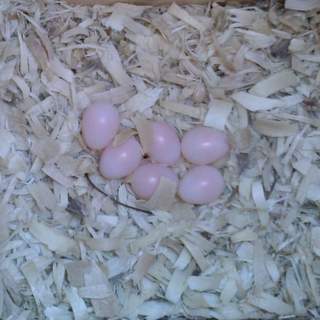 Northern Flicker nest with 6 eggs on May 1
Northern Flicker nest with 6 eggs on May 1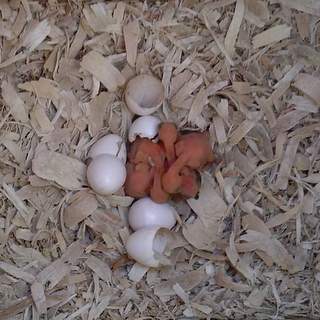 Northern Flicker Nestlings, 1 day old, on May 12
Northern Flicker Nestlings, 1 day old, on May 12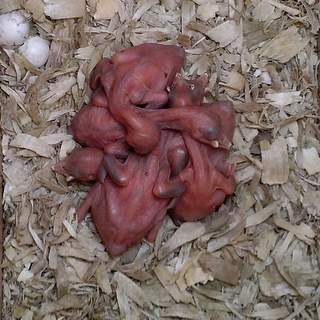 Northern Flicker Nestlings, 5 Days Old, May 16
Northern Flicker Nestlings, 5 Days Old, May 16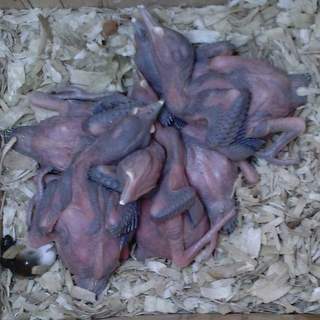 Northern Flicker nestlings, 9 days old, May 20
Northern Flicker nestlings, 9 days old, May 20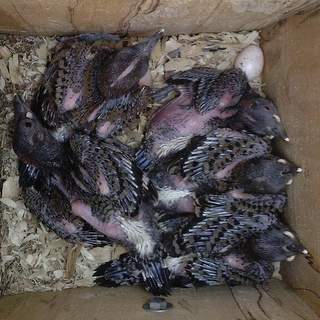 Northern Flicker nestlings, 14 days old, May 25
Northern Flicker nestlings, 14 days old, May 25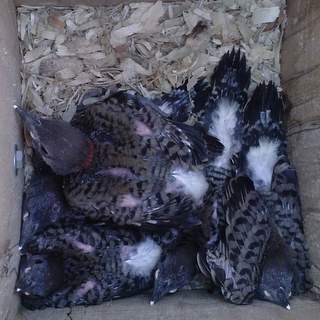 Northern Flicker nestlings, 17 days old, May 28
Northern Flicker nestlings, 17 days old, May 28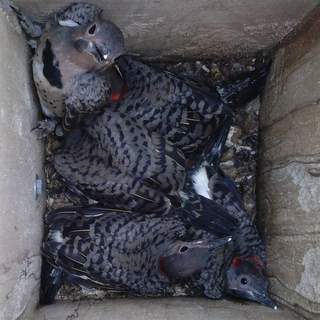 Northern Flicker nestlings, 21 days old, Jun 1
Northern Flicker nestlings, 21 days old, Jun 12015 Lessons Learned
I added a larger nest box which had more floor space (7" x 7" and was deeper (23") than the older nest box whose floor space was 5.5" x 6.6" and was only 20" deep. This was beneficial to the flickers as they need the extra floor space and a deeper box is safer for the nestlings. I trapped starlings all nesting season as well. If I didn't trap starlings, these flickers wouldn't have nested successfully.
2015 Nesting Diary
Mar 8: I've seen the male flicker at four different nest boxes including nest box #1 that I just built over the winter.
Apr 15: I see one flicker at nest box #1 that they tried to nest in last year. I see another at nest box #2 which is larger. I see excavation at both nest boxes. Which box will they choose to nest in?
Apr 19: I see the female flicker at box #1 and the male at box #2. I continue to trap starlings.
Apr 24: I see the female at box #2 and I think this is where they are going to nest.
Apr 26: The flickers have been guarding the nest box non stop, so I think they have eggs. I lower the box and find one egg. I also see a broken egg on the ground, probably the work of a house wren. They probably laid their first egg yesterday.
May 1: There are now six eggs. The eggs should hatch around May 11. I'm continuing to trap starlings with nest box traps.
May 5: At lunchtime I heard a flicker in the box "tap tap tap tap...tap tap tap tap." It was summoning its mate to take over brooding the eggs. After 5 minutes I saw the male stick his head out of the hole. Another five minutes and the female flew up to the hole. The male flew out and she entered the box. Observing nesting flickers is the best.
May 12: Based on their 11 day incubation period, the eggs should be hatched. I open the nest box and find 4 hatchling flickers and one egg. This is the first time that the flickers were able to hatch their eggs in my yard.
May 16: I checked the nestlings and I'm shocked by how much they've grown and by the size differences among the individuals. Some are twice the size of others. There are 5 nestlings.
May 20: Upon opening the nest box I see the flicker babies are all about the same size. Still amazed at the rate of growth.
May 25: The flicker babies have feathers and their eyes are open. I caught another starling today.
Jun 1: The flicker young look like adults now. One was clinging to the side of the box when I checked them.
Jun 4: The nest box seemed quiet so at about 7pm I opened it and there were only 2 flickers in it. The other three must have fledged.
Jun 5: Flicker baby #4 fledges in the morning and #5 in the afternoon. The box is now empty. I inspected the box and they excavacted part of the roof, one corner, and part of the front. Having the flickers nest in my backyard was a glorious experience. I'm sad its all over.
I love seeing this "Shift Change" between the male and the female flickers
Enjoy seeing these Flicker nestlings being fed by their parents
Watch this Nestling Flicker leave the Nestbox
2015 Starling Trappings
From January through May I trapped 123 starlings. This is about 100 less than I trapped last year. Trapping starlings reduces their numbers by more than just the number of birds trapped. For every starling I eliminate this year, it is 6 less starlings that will need to be trapped next year. Starlings raise two broods of young each year. Each brood contains 5 eggs. If all the eggs hatch and all the young survive, each pair could conceivably produce 10 new starlings. That is 10 young plus the two adults. Learn how to trap starlings at European Starling Control.
2016 Flicker Nesting
2016 Nesting Summary
A pair of flickers nested in the silver maple flicker box I built. They had 9 eggs but only 3 of the eggs hatched. While I was at work, a starling drove the flickers away and all 3 nestlings died. I trapped the starling and killed it. The flickers renested in a nest box made of white pine that I built this year. They laid 7 eggs but only 2 hatched. They were able to fledge the two nestlings. I had to continue to trap starlings until the flickers fledged.
2016 Lessons Learned
It’s been a rollercoaster ride watching after the flickers this year. The starlings were a constant threat until the chicks had fledged. I learned a few things along the way. One, Do NOT stop trapping starlings even after the flickers hatch. Two, Continue to provide other starling sized nest boxes to trap starlings before they can destroy the flicker nest. Three, Having a second nest box that flickers can nest in was crucial to having them renest successfully.
2016 Nesting Diary
Mar 9: I arrive home from work to find wood shavings beneath a new nest box I put up a few weeks ago. I believe a flicker excavated it based on the quantity of shavings on the ground. I've seen flickers roosting in 3 other boxes. Hopefully a fourth will take up residence in this box. Starlings are a constant threat. I trapped 3 of them today in nest box traps. I've trapped 29 starlings so far this year in nest box traps.
Mar 11: I set traps in 2 flicker boxes, wood duck box, and screech owl box. Pairs of starlings had usurped all 4 of the nest boxes. The flickers have been roosting in the boxes at night but when they exit in the morning, the starlings moved in. Caught a starling in 3 of the 4 boxes. No starlings entered the wood duck box. I removed the traps and went to work.
Mar 12: At about 7am I opened up the wood duck box to place the nest box trap. I was startled to find TWO DEAD starlings in the box. I removed the box and carried it to a table near my back door. I went inside to put on gloves. When I reached in to get the starlings, they came to life and squealed. One flew out of the box but i grabbed the other one and broke its neck. I think these were two male starlings who had been fighitng for the box to the point of unconsiousness. Starlings will fight each other to the death for a nesting site. I believe these has fought to the point of exhaustion. I believe they kill flickers when they fight for nest boxes. The only way to deal with starlings is to kill them before they can damage the flickers. And the best way to catch them is with nest box traps.
Apr 4: At dusk I thought I’d determine the sex of the flickers that are roosting in my nest boxes. I have 4 boxes that can accomodate flickers and 3 of them are occupied. Surprisingly all 3 birds are males. I’d love it if they all 3 could stay and nest here.
Apr 16: I notice the male and female are always guarding the box. Decide to open it to see if they could possibly have eggs. Guess what. THERE ARE TWO EGGS. First egg was probably laid on Apr 15. This is 11 days ahead of last year’s first egg which was on Apr 26. I must be diligent in keeping the starlings away. So far in 2016 I’ve eliminated 350+ starlings from my yard. Can you say invasive species!
Apr 22: I decided to check the nest box today. I was expecting 7 eggs but was surprised to find 8. Is she going to lay a 9th egg? They don’t seem to be incubating yet so I think 9 is possible. Isn’t that amazing. Must continue to protect flickers from starlings.
Apr 25: There are still 8 eggs.
May 3: I'm somewhat surprised to find 9 eggs. Based on egg coloration, 6 of the eggs look good but 3 look like they won’t hatch.
May 6: Three eggs hatched, but 6 did not. No idea why they didnt hatch.
May 10: I look out this morning and see no flickers. I didn’t see them the night before. Then I see a starling poke his head out of the box. I fear the worst. I go to the box and see broken eggs below the box. I open the box to find 3 dead flicker babies and no eggs. I take down the box and replace it with a smaller box with a trap. Within 10 minutes I’ve caught the starling and killed it. It is a male. A few days before this I took the nest box traps out of the adjacent boxes thinking starling threats were over. I should have never removed the nest box traps. I should have kept trapping starlings until the flickers fledged. I thought once the flickers had babies the starlings wouldn’t bother them. I was wrong. A new lesson learned. YOU MUST TRAP STARLINGS UNTIL THE FLICKERS FLEDGE. I put traps in 4 nest boxes that have 2” holes (perfect for trapping starlings but not flickers as they can't enter a 2" hole).
May 11: I notice both the male and female at different times at a second nest box I put up in the spring. This is the first time I’ve ever seen flickers in this nest box. It is located right outside my back door. Probably not the best location, but I have few open places to put nest boxes. I built this box from one inch white pine.
May 12: I come home after work to find wood shavings below the new nestbox. The flickers seem to have adopted this box. I need more aspen shavings, so make a trip to TSC. Remember not to use pine or cedar shavings as they are too splintered.
May 15: I decide to check the nest box for eggs. I’ve been seeing the flicker pair coming and going from the box daily. There are no eggs. I’m doubtful they will renest.
May 17: I catch a starling in a smaller nest box that contains a trap. It is a male and I kill it. I see the flickers are still at their nest box. I decide to open the box to check for eggs again. I am COMPLETELY DELIGHTED to find TWO EGGS. But the starlings are still a threat, and I believe they are attracted to my yard because of the nesting flickers.
May 18: I come home from work and find TWO starlings trapped in two different nest boxes. They are both male. I am convinced if I didn’t have the traps set the starlings would have gotten the flickers again.
May 19: I caught a great crested flycatcher in one of my nest box traps. I released it unharmed. First time I’ve ever caught a flycather in a nest box trap. I hope it doesn't deter it from nesting in my yard.
May 21: The flickers now have 6 eggs in their second nesting attempt. I still have some nest box traps set for starlings in boxes with 2 inch diameter holes.
May 23: The flickers have a beautiful nest of 7 eggs now. Seems they are done laying for this clutch. Haven’t caught a starling since May 18.
Jun 5: I was out of town for 7 days. Starlings moved into the yard the day I left. I was sure the flickers would be doomed. Before I left I made sure all nest boxes were empty of wood shavings to allow starlings to use them. It seemed to have worked. When I returned the flickers were okay and starlings took up residence in two different nest boxes. I opened the flicker box to find that only 2 of the 7 eggs hatched. There were only 4 remaining eggs. I opened them and all were empty except one had a dead chick in it.
Jun 25: For the past few days the little flickers have been poking their heads out the hole calling for food. Today was their last day in the nest box. Both of them fledged.
Enjoy this Flicker Chick being fed by its parent
2016 Starling Trappings
Again I had to trap starlings during the nesting season. This year I trapped 70 starlings up to May. This was about 30 more than last year. I made the mistake of ceasing trapping once the flicker's had chicks. This was a big mistake as a starling usurped the box and the flicker chicks all died. Learn how to trap starlings at European Starling Control.
2017 Flicker Nesting
2017 Nesting Summary
A miraculous occurrance happened this year. THREE different pairs of flickers nested in my yard in three separate nest boxes. I really didn't think this was possible as flickers supposedly don't share nesting territory. The first pair nested in the nest box made of white pine located outside my back door. They laid 7 eggs and raised 4 chicks. The second pair nested in the nest box made of silver maple located in the garden. Of the 7 eggs only 1 hatched. The third pair moved into the screech owl box but it isn't as deep as the other boxes. I replaced it with the wood duck box that had been in the garden. They adopted the wood duck box and laid 5 eggs and only one egg hatched. The chick disappeared after one day. I do not believe starlings destroyed this nest. It could have been another flicker pair but I think it was a red-bellied woodpecker. I had seen one looking in one of the nest boxes earlier.
2017 Lessons Learned
This year I found that having three flicker sized nest boxes spaced around the property can provide for multiple pairs to nest.
2017 Nesting Diary
Apr 3: Saw both male and female at nest. Upon checking the nest box I find that the wood shavings have been nearly all excavated
Apr 13: After being gone for a week, I check the flicker nest box and find that almost all the wood shavings have been excavated. I add about 6 inches of shavings.
Apr 14: After hearing pecking at the flicker nest box I decide to look for eggs. The first egg of the year has been laid. This is one day earlier than last year. This is the nest box that they used last year to raise the 2nd nesting attempt.
Apr 17: The female just exited the nest box and landed on a branch. She saw the male and flew toward him. She then took a submissive posture and he mated with her. He flew off and she returned to the nest box.
Apr 20: The pair of flickers now have 7 eggs.
Apr 28: After being out of town for 5 days I was worried that starlings would drive away the flickers. When I approach the box, a flicker flew out. All was well. I checked the eggs and there are still 7 but only 2 of them look pink. I think that means they have a chick inside. The others are white. We will see how many hatch.
May 2: Three of the seven eggs have hatched. The chicks are already vocalizing.
May 3: Caught a female starling in the nestbox next to the flickers. Trapping starlings in nearby nestboxes is my method of keeping the starlings from destroying the flicker nest.
May 4: One more egg hatched. There are now 4 flicker chicks. The parents are taking care of them nicely. Hopefully they find lots of ants for the chicks.
May 5: Today I hear a peck peck peck and think its time for the flickers to have a shift change at the box. But no bird showed up. I kept watching and saw the male flicker from the resident nest box fly to the other box. He kept calling and looking in. Finally he entered. I didn’t really hear a comotion and then I saw him exit. I kept watching the other box and finally a male flicker appeared at the hole. Later I saw a female show up at the box. I also saw 3 flickers at the box at one point. I’m not sure if the resident flickers will allow a second pair to nest so closely to them. Maybe they won’t mind since their eggs have hatched. The boxes are about 30 feet apart.
May 6: It was a distressing day today as the male resident flicker chased the intruder male all day long. They got into a number of fights with beaks locked. I found flicker feathers from their fighting. Both birds were visibly exhausted. I hope the female was able to feed the chicks AND keep them warm. At the end of the day I decided to take the second nest box down hoping the new pair would move on. That didn’t work and the intruder appeared at the resident’s nest box. I put the box back up and pointed it in the opposite direction of the resident box. Not sure that will help that much. I’m not sure what to do at this point.
May 7: Today was a much better day. The flicker males seem to be getting along much better. There was some chasing but nothing like yesterday. Maybe turning the box away from the resident box helped. This afternoon I saw THREE flickers on the “intruders” nest box. I was surprised to see TWO FEMALES with the male. They did their head wagging and flicker calls. The male looked at each female and pecked at one. She flew to the ground. I assume he decided he didn’t like her and liked the other one better. Watching the flickers is like watching a reality dating show. I also checked the resident box. All four chicks have grown tremendously and are looking good.
May 8: While in the garden I noticed wood shavings all over the ground. Throughout the day I saw shavings falling from the box and occassionally would see a flicker fly off with a beak full of shavings. I think the pair has bonded as I saw them mating on top of the nest box. I did see one run in with the resident male where they were facing each other in a tree. It didn’t last long. I also checked the resident box and took out the 3 unhatched eggs. I cracked each open and 2 were full of a watery substance. One had a mass in it and may have been an embryo. It appears the two pairs are going to nest in my yard at the same time. Just have to keep the starlings at bay.
May 10: Checked the 2nd pair of flickers’ nest box for eggs but they haven’t laid yet. Later in the day I saw one carrying out more wood shavings. They are still excavating. I caught a female starling in one of my nest box traps. Unrelated to flickers, a pair of chickadees began nest building in a nest box on my patio.
May 11: The 2nd pair of flickers have their first egg!
May 13: Caught two male starlings in nest box traps. It’s critical to keep the starlings from destroying the flicker nests. The 1st pair of flickers’ babies have their eyes opened.
May 15: The 2nd pair of flickers now have 5 eggs! I saw the dad of the 1st pair land on the nest box and pecked twice on the box. This was a signal to the female that he had arrived and has food to feed the kids. The mom exited and he entered. I just love watching them.
May 17: The 2nd pair of flickers seem to have stopped at 6 eggs. They should have had 7 today if they laid one egg per day. The 1st pair of flickers babies are feathered and have their white rump.
May 21: Checked on the 2nd pair and now they have 7 eggs. I wonder if they skipped a day or if something took an egg. The 1st pair’s kids are coming to the hole to be fed.
May 24: The first flicker from the 1st pair has left the nest box. I heard one calling from the tree and though it sounded like a baby and not an adult. I opened the box and only 3 are left. They look like full grown flickers. Feels SO GOOD to see another successful pair of flickers. This was possible because I controlled the starlings. In the process I killed 190 starlings this year, 32 of which were caught in nest box traps.
May 25: The rest of the baby flickers left the box today. One left when I lowered the box. Another left when I raised the box back up. The fourth left in the afternoon.
Jun 2: After being gone a week, I was excited to check on the 2nd pair of flicker’s nest. I was expecting to find a nest full of baby flickers. Instead I found only ONE. there were SEVEN eggs that did not hatch. One egg is smaller than the rest. I really wonder why fertility is so low in these birds.
Jun 3: Another big surprise, a 3rd pair of flickers have moved into the wood duck box. This location had a screech owl box that the flickers were showing interest in. But I replaced the screech owl box with a wood duck box as it is much deeper. I thought they had abandoned this site but today I found 2 eggs in the box and the pair is guarding it constantly.
Jun 7: The 3rd pair of flickers have 5 eggs
Jun 16: The pair still has 5 eggs.
Jun 18: One egg has hatched but one egg also disappeared.
Jun 19: No other eggs have hatched and the chick has disappeared.
Jun 20: Still no other eggs have hatched. I decide to break them open. They are all watery inside. I am perplexed why so few of the eggs are hatching
Watch these flicker chicks progress from hatching to fledgling
2017 Starling Trappings
Again I had to trap starlings during the nesting season. This year I caught 32 starlings in nest box traps through May. This was 40 less than I caught last year in nest box traps. I'm not sure why the drop. But 30 to 40 is the number I usually catch. Learn how to trap starlings at European Starling Control.
2018 Flicker Nesting
2018 Nesting Summary
This was a relatively good year for the flickers. Four of the five nestlings fledged. The smallest one didn't make it. The year did not start out well at all. The flickers were nesting in a different 24" nest box. But while I was gone, starlings came and moved in. The starlings forced the flickers to start a new nest. Luckily my yard is set up with 3 different flicker boxes. The starlings had other places they could have nested but they wanted the flicker nest.
2018 Lessons Learned
It is important to have more than one nest box that flickers can use. The starlings evicted them from one box so they went to another nest box. I of course trapped and killed the starlings.
2018 Nesting Diary
Apr 17: Starlings came and moved into the large nest box that the flickers are using. I replaced the nest box with a flycatcher box set wtih a trap. Caught the starling. Put the flicker box back up
Apr 23: I left on vacation for 9 days. I assume the flickers started a clutch of eggs while I was gone.
May 2: I returned from vacation. The flickers are no longer at the 24" box as starlings took over the box. The flickers have moved to the 20" box. They have 7 eggs. I replaced the 24" flicker box with a flycatcher box set with a nest box trap. I caught the starling and replaced the 24" flicker box.
May 12: There are still 7 eggs. All looks well.
May 20: The eggs have hatched. There are 5 chicks and 2 eggs. I removed the eggs as they were duds.
May 24: The five chicks are partially feathered. I put a stove pipe baffle on the box in case snakes try to climb up to get the nest.
May 26: Saw both the female and the male at the box. I was worried something had happened to one of them as I had only been seeing one.
Jun 2: The box is filthy so i add more wood shavings. The young are fully feathered.
Jun 4: I see the parents calling outside the box, trying to get the young to fledge
Jun 5: I saw a chick fledge. It did not make it to a tree but landed on the ground. I see a cat. People should keep their cats indoors
Jun 6: The last chick fledged. There was one dead chick in the box. It was the smallest chick.
2019 Flicker Nesting
2019 Nesting Diary
Mar 27: To prepare for the coming nest season, I empty the nest box of old shavings and flicker poop. Flickers use the nest boxes as roosts all winter. I add aspen shaving and fill the boxes over half full. I already notice the flickers are excavating shavings!
Apr 9: I notice the female at the box daily and decide to check the box. The wood shavings have been excavated. This must be teh box they are going to nest in.
Apr 14: The female seems to be guarding the box. I open it up and discover the FIRST egg. I am thrilled.
DISCLAIMER: This page contains affiliate links in the right hand panel, which means that if you click on one of the product links, I’ll receive a small commission. This helps support my website and allows me to continue to add new content. Thank you for the support!
